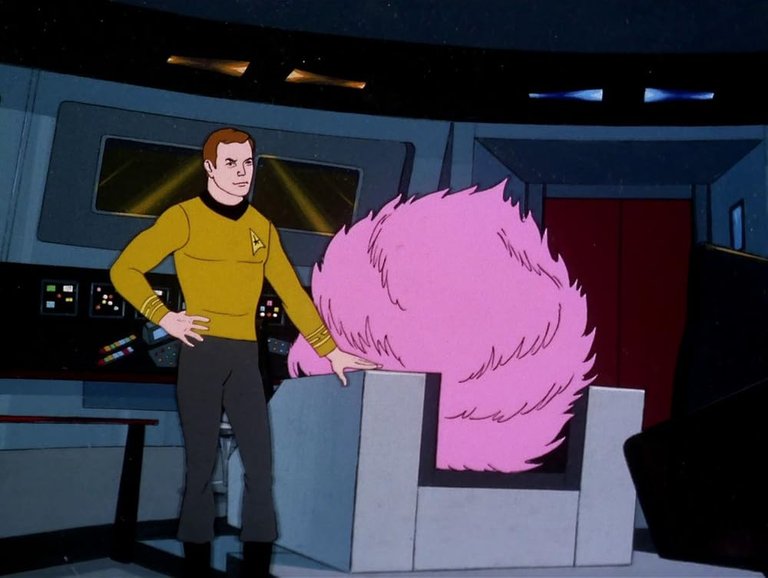Television Review: More Tribbles, More Troubles (Star Trek: The Animated Series, S1X05, 1973)

More Tribbles, More Troubles (S02E05)
Airdate: October 6th 1973
Written by: David Gerrold
Directed by: Hal Sutherland
Running Time: 22 minutes
The Trouble with Tribbles is frequently cited as the most beloved episode of Star Trek: The Original Series (TOS), and its whimsical blend of comedy, tension, and clever worldbuilding has secured it a place among the most celebrated instalments in the entire Star Trek franchise. It is thus no surprise that such a popular episode would inspire a sequel, much like the phenomenon of cinematic sequels capitalising on a beloved source material. The Animated Series (TAS) episode More Tribbles, More Troubles, written by the original’s creator David Gerrold, emerged as a direct follow-up to that iconic story, capitalising on the enduring appeal of tribbles and the Star Trek universe’s established lore. While the animated format presented both opportunities and constraints, the episode’s existence underscores the franchise’s willingness to revisit its most cherished moments, even if the results were inevitably tempered by the realities of its medium.
The origins of More Tribbles, More Troubles are as interesting as its narrative. Gerrold, who wrote the original script for The Trouble with Tribbles, had initially intended it to be part of TOS’s third season, but the show’s cancellation in 1969 scuppered those plans. Despite Gerrold’s public critiques of Gene Roddenberry in his 1973 book The World of Star Trek—particularly his dissatisfaction with Roddenberry’s creative decisions—the pair maintained mutual respect. This respect led Roddenberry to invite Gerrold to contribute to TAS, a decision that allowed the writer to revisit his most famous creation. More Tribbles, More Troubles became the first episode produced for TAS, though it aired fifth in the series’ run. A charming touch was Gerrold’s cameo as a crewman aboard the Enterprise, a nod to his involvement in shaping the story. This episode thus stands as a bridge between TOS’s legacy and the experimental, if uneven, animated series that followed.
The plot of More Tribbles, More Troubles unfolds with the Enterprise escorting two robot grain ships to Sherman’s Planet, a world recovering from famine. During the journey, the crew encounters a Klingon battlecruiser intercepting a Federation scout ship. After rescuing the scout’s sole survivor—Cyrano Jones, the roguish trader responsible for the tribble infestation in *The Trouble with Tribbles?—the crew learns of a new twist. Jones explains that the tribbles he now carries are a genetically modified variant: instead of reproducing exponentially, they grow to enormous sizes, a trait he claims was counterbalanced by introducing glommers, tribble predators. However, the glommer have since been unable to deal with oversized prey, leaving the Enterprise to contend with rapidly expanding tribbles that threaten to overwhelm the ship. Meanwhile, the Klingon captain Koloth demands the return of Jones and the glommer, revealing the creature was engineered by the Klingons themselves to combat a tribble plague on their territory. The ensuing conflict pits Kirk and Spock against the Klingons’ advanced energy weapon, which drains quickly but incapacitates targets, forcing the crew to find a diplomatic resolution.
The episode’s most glaring limitation is its medium. While TOS’s live-action format allowed for rich character moments and nuanced dialogue, TAS’s animation—despite its vibrant aesthetic—struggled to replicate that depth. The condensed runtime of TAS episodes, typically under 20 minutes, further restricted opportunities for subplots or intricate worldbuilding. More Tribbles, More Troubles, at just 22 minutes, feels rushed in comparison to the original’s 50-minute runtimeEven the tribbles themselves, now giants instead of swarms, lack the same charm as their predecessors, their physical comedy overshadowed by the plot’s urgency. The Klingons, too, are reduced to adversaries rather than nuanced antagonists, their motives rooted in a simplistic desire for control rather than the political intrigue of the original episode.
Despite these constraints, Gerrold’s script demonstrates a deft hand at balancing homage and originality. The core elements of The Trouble with Tribbles—Kirk’s leadership, Spock’s logic, and the comedic chaos of alien creatures—are preserved, even if their execution is scaled down. Stanley Adams, who portrayed Cyrano Jones in the original, returns to voice the character, infusing the role with the same sly charm that made him memorable. However, the absence of William Marshall, who voiced Koloth in TOS, is keenly felt. Replaced by James Doohan (Scotty), the role lacks Marshall’s gravitas, rendering Koloth’s threats less intimidating. The energy weapon and glommer plotlines, while inventive, feel tacked-on, serving more as plot devices than meaningful extensions of the universe.
The episode’s comedic moments are mild compared to the original’s brilliance. The tribbles’ rapid growth provides some visual gags but their novelty is undercut by the episode’s brevity. The resolution feels rushed, skipping over the moral dilemmas and interpersonal dynamics that elevated the original. Even the glommer’s introduction, a clever nod to ecological balance, is underexplored, its significance confined to a quick reveal.
Ultimately, More Tribbles, More Troubles is a serviceable entry in the Star Trek canon, but it lacks the spark that made its predecessor immortal. It succeeds as a faithful homage, retaining the spirit of its source material while acknowledging the creative and practical boundaries of TAS. For fans of Gerrold’s work or TAS, it offers a glimpse into the writer’s creative process and the series’ attempt to sustain TOS’s legacy. Yet, it is a reminder of the challenges inherent in adapting beloved stories into a constrained format. The episode’s value lies not in surpassing its predecessor but in existing as a curious footnote—a testament to Star Trek’s enduring charm and the industry’s willingness to revisit its triumphs, even when the results are less than ideal.
RATING: 6/10 (++)
Blog in Croatian https://draxblog.com
Blog in English https://draxreview.wordpress.com/
InLeo blog https://inleo.io/@drax.leo
InLeo: https://inleo.io/signup?referral=drax.leo
Leodex: https://leodex.io/?ref=drax
Hiveonboard: https://hiveonboard.com?ref=drax
Rising Star game: https://www.risingstargame.com?referrer=drax
1Inch: https://1inch.exchange/#/r/0x83823d8CCB74F828148258BB4457642124b1328e
BTC donations: 1EWxiMiP6iiG9rger3NuUSd6HByaxQWafG
ETH donations: 0xB305F144323b99e6f8b1d66f5D7DE78B498C32A7
BCH donations: qpvxw0jax79lhmvlgcldkzpqanf03r9cjv8y6gtmk9